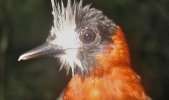Birds have played a central role in advancing our understanding of evolution, beginning with the research of Charles Darwin himself. Wild birds in the Galápagos (mockingbirds and the eponymous Darwin’s finches) helped Darwin solidify his thoughts about common descent and natural selection, and breeding fancy pigeons (domesticated Rock Pigeons) contributed to his knowledge of heritability and species variation. Birds also played an important role in the development of the modern evolutionary synthesis, with major figures Julian Huxley, Ernst Mayr, and Bernhard Rensch basing much of their theories on ornithological data.
In this Evolution section, we present a brief summary of what these pioneering evolutionary biologists and many others have discovered about bird evolution. Since their origins in the time of dinosaurs, birds have evolved into a myriad of species that fill a spectacular array of ecological niches on all continents. They have adapted to survive and thrive in harsh polar oceans, humid and hot rain forests, and extremely dry deserts. They range in length from two inches up to nine feet and in weight from 0.05 ounce to 340 pounds, they have ultraviolet vision, and some can be heard up to 5 miles away! This incredible variety of life—over 10,000 extant species—is the result of over 150 million years of avian evolution.
Follow the links above to learn about a variety of processes and facts concerning bird evolution. Are birds really just the last remaining dinosaurs? Check out the Birds & Dinosaurs section to learn why many ornithologists now adopt this viewpoint. Why do longclaws in Africa and meadowlarks in the Americas have almost identical plumage patterns, despite being distantly related? You can learn about this and other examples of convergent evolution at the Convergence link. Did you know that falcons and hawks are not very closely related? Head over to the Taxonomic Relationships section to learn about this and other surprising results from recent DNA studies, including those conducted by Field Museum scientists. The remaining sections (Adaptation, Variation, and Selection) explain some aspects of the “nuts and bolts” of bird evolutionary processes.








